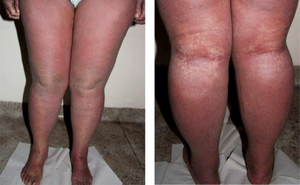Papuloerythroderma of Ofuji
Jump to navigation
Jump to search
| Papuloerythroderma of Ofuji | |
|---|---|
 | |
| Edema of lower extremities. Parts of the skin without lesions in the popliteal area (deck-chair sign) | |
Papuloerythroderma of Ofuji is a rare disorder most commonly found in Japan, characterized by pruritic papules that spare the skinfolds, producing bands of uninvolved cutis, creating the so-called deck-chair sign. Frequently there is associated blood eosinophilia. Skin biopsies reveal a dense lymphohistiocytic infiltrate, eosinophils in the papillary dermis, and increased Langerhans cells (S-100 positive). Systemic steroids are the treatment of choice and may result in long-term remissions.[1]: 57 [2]
It was characterized in 1984.[3][4]
Use of PUVA in treatment has been described.[5]
See also
References
- ↑ James, William; Berger, Timothy; Elston, Dirk (2005). Andrews' Diseases of the Skin: Clinical Dermatology. (10th ed.). Saunders. ISBN 0-7216-2921-0.
- ↑ Rapini, Ronald P.; Bolognia, Jean L.; Jorizzo, Joseph L. (2007). Dermatology: 2-Volume Set. St. Louis: Mosby. ISBN 978-1-4160-2999-1.
- ↑ Torchia D, Miteva M, Hu S, Cohen C, Romanelli P (March 2010). "Papuloerythroderma 2009: Two New Cases and Systematic Review of the Worldwide Literature 25 Years after Its Identification by Ofuji et al". Dermatology. 220 (4): 311–320. doi:10.1159/000301915. PMID 20339287. Archived from the original on 2019-05-18. Retrieved 2021-02-01.
- ↑ Ofuji S, Furukawa F, Miyachi Y, Ohno S (1984). "Papuloerythroderma". Dermatologica. 169 (3): 125–30. doi:10.1159/000249586. PMID 6148269.
- ↑ Günter Burg; Werner Kempf (2005). Cutaneous Lymphomas. Informa Health Care. pp. 365–. ISBN 978-0-8247-2997-4. Retrieved 30 May 2010.
External links
| Classification |
|---|